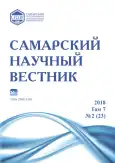Epidemiological transition of the urban Middle Volga Region population
- Authors: Rumyantseva M.A.1
-
Affiliations:
- Branch of Samara State Technical University in Novokuibyshevsk
- Issue: Vol 7, No 2 (2018)
- Pages: 188-191
- Section: 07.00.00 – Historical Sciences and Archaeology
- URL: https://journals.rcsi.science/2309-4370/article/view/21768
- DOI: https://doi.org/10.17816/snv201872209
- ID: 21768
Cite item
Full Text
Abstract
The epidemic transition is the most important part of the demographic transition, which in turn determines the current trends in fertility and mortality in modern Russia. The paper attempts to trace the main regional features of the process by the example of the Middle Volga Region. Using the statistics reported in the census, statistical handbooks, central and local archives, the author traces the changes in morbidity and mortality of the urban population of the Middle Volga Region, making the conclusion that the epidemiological transition in the region was essentially completed in the period of the Khrushchev thaw. There was also a rapid increase in mortality from malignant neoplasms and circulatory diseases, which is characteristic of the final stage of the epidemic transition. The author of the paper revealed some «lag» of the region in terms of exogenous morbidity. It was associated with the rapid growth of industry in the region, and as a consequence, not always appropriate conditions of hygiene and life of the urban population. However, mortality trends in the Middle Volga Region corresponded to those in the RSSR as a whole, which was primarily due to the achievements of medicine of the time: the emergence of antibiotics, mass vaccination of the population, improving the quality of medical services.
Full Text
##article.viewOnOriginalSite##About the authors
Maria Aleksandrovna Rumyantseva
Branch of Samara State Technical University in Novokuibyshevsk
Author for correspondence.
Email: rumjanseva@rambler.ru
candidate of historical sciences, associate professor of Economics and Management Department
Russian Federation, Novokuibyshevsk, Samara regionReferences
- Румянцева М.А. Демографическая ситуация в городах Поволжья в 1955-1965 годах: дис. … канд. ист. наук: 07.00.02. Самара, 2003. 208 с.
- Кваша А.Я. Демографическая политика в СССР. М.: Финансы и статистика, 1981. 200 с.
- Боярский А.Я. Население и методы его изучения. М.: Статистика, 1975, 264 с.
- Вишневский А.Г. Воспроизводство населения и общество: история, взгляд в будущее. М.: Финансы и статистика, 1982. 287 с.
- Вишневский А.Г. Демографическая революция. М.: Статистика, 1976. 240 с.
- Брачность, рождаемость, смертность в России и в СССР: сб. статей / под ред. А.Г. Вишневского. М.: Статистика, 1977. 246 с.
- Андреев В.М. Продолжительность жизни причины смерти в СССР // Демографические процессы в СССР. М., 1990. С. 90-92.
- Андреев Е.М., Дарский Л.Е., Харькова Т.Л. Демографическая история России: 1927-1957. М.: Информатика, 1998. 197 с.
- Жиромская В.Б. Основные тенденции демографического развития России в ХХ веке. М.: Кучково поле, 2012. 320 с.
- Исупов В.А. Эпидемический переход в России: взгляд историка // Демографическое обозрение. 2016. Т. 3, № 4. С. 82-92.
- Семенова В.Г. Обратный эпидемиологический переход в России. М.: ЦСП, 2005. 235 с.
- Репинецкий А.И., Румянцева М.А. Городское население Среднего Поволжья в послевоенное двадцатилетие. 1945-1965 гг.: очерки демографической истории. Самара: Изд-во «НТЦ», 2005. 262 с.
- Российский государственный архив экономики (РГАЭ). Ф. 1562. Оп. 37. Д. 2615.
- РГАЭ. Ф. 1562. Оп. 44. Д. 2601.
- Текущий архив Самарского областного комитета государственной статистики (ТАСОКГС). Папка № 12. Л. 24-37.
- Естественное и механическое движения населения РСФСР. М., 1960. 240 с.
- Население Куйбышевской области от переписи 1959 г. до переписи 1979 г. Куйбышев: Статистика, 1980. С. 9-14.
- Народное хозяйство РСФСР в 1958 г. М., 1959. 508 с.
- Государственный архив Российской Федерации (ГАРФ). Ф. А-374. Оп. 30. Д. 9629.
- ГАРФ. Ф. А-374. Оп. 31. Д. 7841.
- ГАРФ. Ф. А-374. Оп. 31. Д. 7850.
- ГАРФ. Ф. А-374. Оп. 31. Д. 1845.
- ГАРФ. Ф. А-374. Оп. 32а. Д. 7001.
- ГАРФ. Ф. А-374. Оп. 35. Д. 3114.
- ГАРФ. Ф. А-374. Оп. 35. д. 3115.
- Центральный государственный архив Самарской области (ЦГАСО). Ф. Р-2521. Оп. 26. Д. 1037.
- ЦГАСО. Ф. Р-2558. Оп. 10. Д. 1114.
- Шувалова Е.П. Инфекционные болезни. 3-е изд., перераб. и доп. М.: Медицина, 1990. 558 с.
- Румянцева М.А. Городское население Среднего Поволжья в 1956-1965 гг. Материалы к изучению демографической истории: сб. материалов и документов. Самара: СамГТУ, 2012. 176 с.
- ГАРФ. Ф. А-374. Оп. 30 Д. 6883.
- ГАРФ. Ф. А-374. Оп. 30 Д. 9666.
- ГАРФ. Ф. А-374. Оп. 30 Д. 12026.
- ГАРФ. Ф. А-374. Оп. 31 Д. 4957.
- ГАРФ. Ф. А-374. Оп. 32 Д. 3105.
- РГАЭ. Ф. 1562. Оп. 37 Д. 2711.
- РГАЭ. Ф. 1562. Оп. 44 Д. 2774.
- ЦГАСО. Ф. Р-2521. Оп. 25 Д. 905.
- Репинецкий А.И. Демографический состав работников промышленности Поволжья (1945-1965). Самара: СамГПУ, 1996, 132 с.
- ГАРФ. Ф. А-374. Оп. 30. Д. 9643.
- ГАРФ. Ф. А-374. Оп. 30. Д. 11996.
- ГАРФ. Ф. А-374. Оп. 31. Д. 7853.
- РГАЭ. Ф. 1565. Оп. 44. Д. 2625.
- ЦГАСО. Ф. Р-4054. Оп. 4. Д. 735а.
Supplementary files






